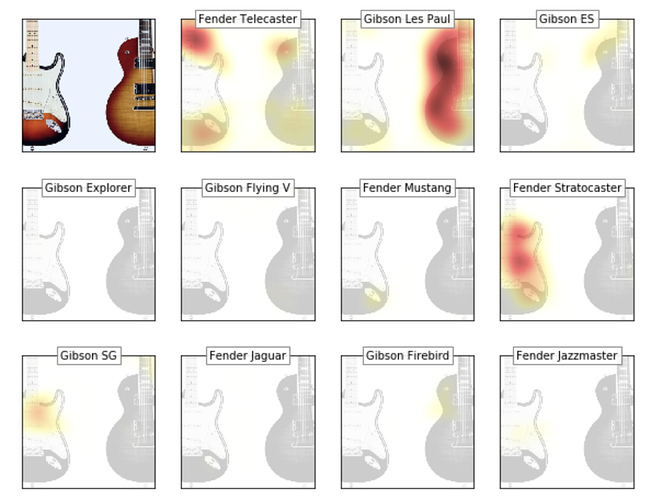cwerner
November 12, 2018, 12:47pm
1
Hi.
I’m trying to implement Grad-CAM as nicely shown by @henripal and @MicPie here:https://forums.fast.ai/t/visualizing-intermediate-layers-a-la-zeiler-and-fergus/28140/25?u=cwerner
@henripal is using the learner to access an image batch
next(iter(learn.data.train_dl))
Now, in my case I don’t have that anymore, I load the model and do inference on an image (till now with predict()) like so:
MODEL = 'stage-2.pth'
path = Path("/tmp")
data = ImageDataBunch.single_from_classes(path, labels, tfms=get_transforms(max_warp=0.0), size=299).normalize(imagenet_stats)
learn = create_cnn(data, models.resnet50)
learn.model.load_state_dict(
torch.load("models/%s" % MODEL, map_location="cpu")
)
I setup the hooks as suggested in the post, but I fail to make it work with my setup… How do I go from my Image file to a tensor that fits the model (ResNet-50, 299px)?
In the example out = learn.model( img_tensor )is used …
I somehow need to go from my image to a tensor in the right format… Any kind soul know where I should look?
1 Like
henripal
November 12, 2018, 1:29pm
2
Can you share a minimum working example NB?
cwerner
November 12, 2018, 1:41pm
3
Yeah.
I’ll clean up my mess a bit and link it…
C
cwerner
November 12, 2018, 1:54pm
4
Here it is…
I’m not sure about the image loading (I did a hack, but this is not what I think is right).
inference_gradcam-Copy1.ipynb
{
"cells": [
{
"cell_type": "markdown",
"metadata": {},
"source": [
"# Guitar Classifier - Inference and cam\n",
"\n",
"model and image: https://www.dropbox.com/sh/wy5uhhxmxghxci0/AADbPnM5-6PcJ1GvRlI6nbJOa?dl=0 \n",
"rough draft, based on: \n",show original
The model and test image are at this dropbox link:https://www.dropbox.com/sh/wy5uhhxmxghxci0/AADbPnM5-6PcJ1GvRlI6nbJOa?dl=0
henripal
November 12, 2018, 3:47pm
5
Here’s what I did to make it work:
Making sure that the tensor transformation is the correct one by just adding your image to the dataset
learn.data.valid_ds.set_item(img)
tensor_img = list(learn.dl())[0][0]
out = learn.model(tensor_img)
I’m not super sure but I think the adaptive pooling is messing with my hardcoded dimensions so I corrected the reshapes as follows:
_, n, w, h = gradients.shape
fmaps = fmap_hook.stored.cpu().numpy().reshape(n, w, h) # reshape activations
Here’s the full working example here:
guitar_gradcam.ipynb
{
"cells": [
{
"cell_type": "markdown",
"metadata": {},
"source": [
"# Guitar Classifier - Inference and cam\n",
"\n",
"model and image: https://www.dropbox.com/sh/wy5uhhxmxghxci0/AADbPnM5-6PcJ1GvRlI6nbJOa?dl=0 \n",
"rough draft, based on: \n",show original
2 Likes
cwerner
November 12, 2018, 5:00pm
6
Oh wow. Super cool. Thanks for that…
Another silly question if you don’t mind. I try to get the original image to overlay it with the grad-cam result…
However, I’m not sure if I calculate it correctly from the tensor:
t = np.transpose(tensor_img.squeeze(), (1, 2, 0))
print(t.min(), t.max())
plt.imshow((t - t.min())/t.max())
The colors seem to be off. Not sure if the is actually a transformation or if I do not de-normalize correctly? Is there a more elegant solution for this?
henripal
November 12, 2018, 5:03pm
7
Your max is different after doing t - t.min() I think - you probably have some pixels with >1.0 values
1 Like
cwerner
November 12, 2018, 5:26pm
8
Sure thing. This is correct:
t = (t - t.min()) / (t.max() - t.min())
Thanks again for helping out
1 Like
cwerner
November 12, 2018, 9:18pm
9
As a followup, here is the updated version:
inference_and_gradcam.ipynb
{
"cells": [
{
"cell_type": "markdown",
"metadata": {},
"source": [
"# Guitar Classifier - Inference and cam\n",
"\n",
"rough draft, based on: \n",
"https://github.com/henripal/maps/blob/master/nbs/big_resnet50-interpret-gradcam.ipynb\n",show original
Unfortunately I am stuck again. In the second gist I try to get grad-CAMs for all 11 classes…
However, the CAMs I get look wrong. I guess something is up with the way I store backdrop results?
inference_and_gradcam_bad.ipynb
{
"cells": [
{
"cell_type": "markdown",
"metadata": {},
"source": [
"# Guitar Classifier - Inference and cam\n",
"\n",
"rough draft, based on: \n",
"https://github.com/henripal/maps/blob/master/nbs/big_resnet50-interpret-gradcam.ipynb\n",show original

